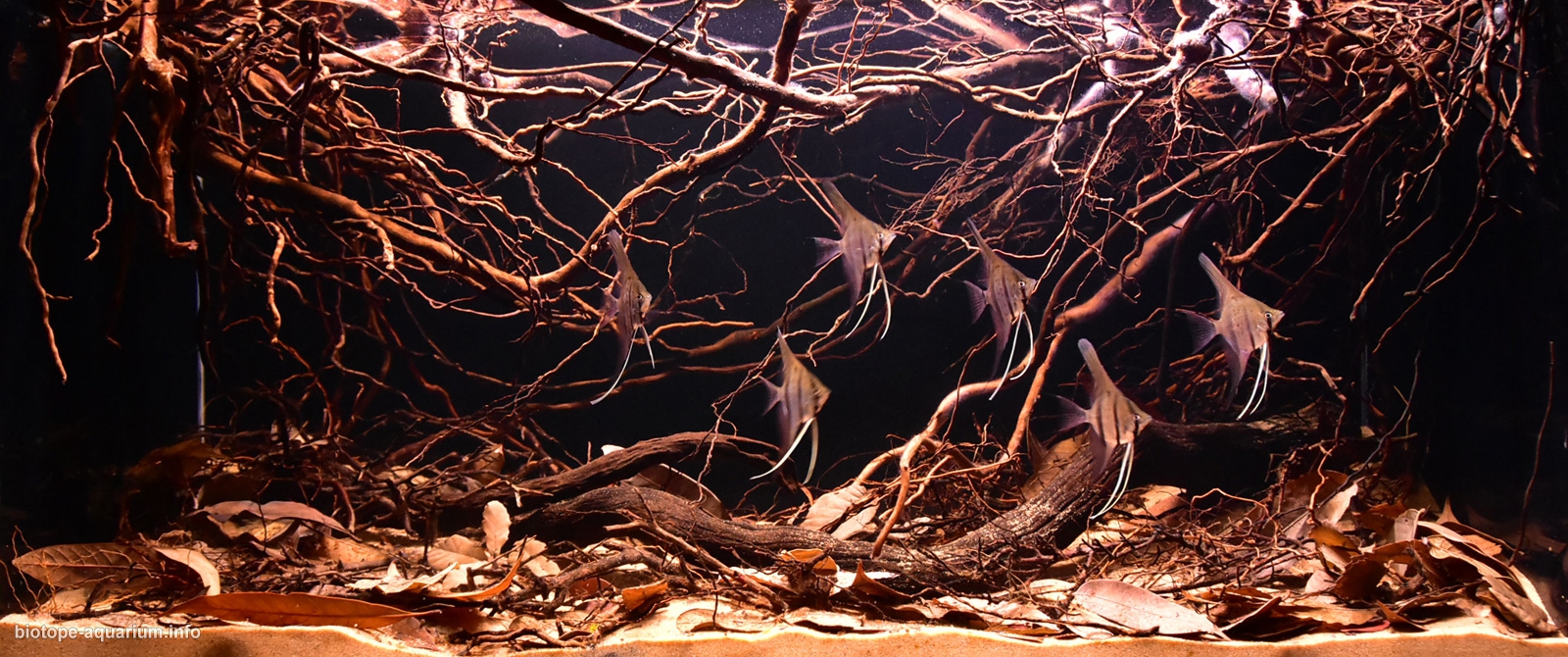Rio Nanay, Amazon River tributary, Peru
49th place in Biotope Aquarium Design Contest 2018
![]() China. Wang Peng
China. Wang Peng

Volume: 182 L
Dimensions: 90x45x45 cm
List of fishes: Pterophyllum scalare sp. “Rio Nanay”
List of plants: N/A
Description of decorations: River sand , drift wood ,Oak Leaves Origin in China.
Description of equipment: External ATMAN CF1200×1
Netlea Led 50W ×2.
Water parameters: Water is dark brown, also known as Heishui river.PH6,GH20.
INFORMATION ABOUT BIOTOPE
Description of the area surrounding the biotope: Ro Nanay is a river of Peru in the Loreto region of northeastern Peru. It runs 315 kilometers and is a tributary of the Amazon River with an area of 17,600 square kilometers. The Narni River is a black-water river with slow meandering currents, dense swamps and lagoons, and abundant fish resources, including many well-known ornamental fish species. The Narni River is 3.5 km/2.2 miles from Iquitos, where hundreds of favorite species of fish live, the most famous of which is the colorful immortal fish. Green colourful was introduced into the Nai river because of an accident. There are also some royal fish, but it is hard to see.
Description of the underwater landscape of the biotope: The Rio Nanay is a black river surrounded by forests. In the rainy season, it breaks through the banks, drowns the nearby forests, and breaks the trees in the water. There are a lot of dead leaves and floating trees gathered in the bottom of the water. The bottom is sandy. A lot of branches are inserted into the water, which brings a natural barrier for fish. No stones or water grass were found in the water.
Description of the parameters of the habitat: In the dry season, its average temperature is 28 degrees C / 82 degrees F, pH is about 6, and conductivity is 25-50 S. In the rainy season, conductivity decreased to 15 S. The river flow depends on the depth of the season and water (usually 5m / 16 inches).
List of fishes and invertebrates occurring in the nature biotope: P. Scalare Rio Nanay.Pterophyllum aitum,Pristella maxillaris. In my original landscaping, I chose Pristella maxillaris. Sternarchorhynchus higuchii. Brycon cephalus. Tympanopleura brevis. Auchenipterus ambyiacus. Callichthys callichthys. Hoplosternum littorale. Gymnorhamphichthys petiti. Synbranchus marmoratus. Anodus elongatus.
List of plants found in the nature biotope: Lemna minor.
Threats to the ecology: When human beings appear in the natural ecological environment, the deforestation of forests and the abandonment of wild fish have seriously destroyed the balance of the natural environment. River pollution, a large number of sand mining, but also a serious threat to the balance of natural ecology.
Sources of information:
http://wemedia.ifeng.com/
http://bbs.tropica.cn/thread-
http://a1.qpic.cn/psb?/
http://a2.qpic.cn/psb?/
http://a1.qpic.cn/psb?/
http://a1.qpic.cn/psb?/
http://a1.qpic.cn/psb?/
http://a1.qpic.cn/psb?/
http://a4.qpic.cn/psb?/
Comments of the members of the jury of Biotope Aquarium Design Contest 2018

These fishes must be housed in a bigger tank. They grow fast to a size that isn’t compatible with this size of tank.
